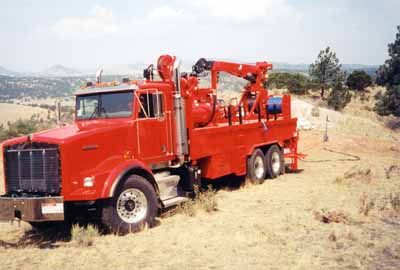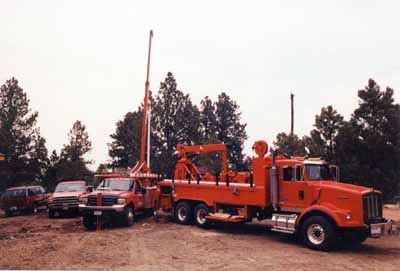
"Then, we did a handful of them afterward and everyone of them worked," he recalls.
Wiley didn't find the first well he hydrofractured not working discouraging at all.
"We're used to it," Wiley says. "We're used to seeing some of them not work."
Wiley's friend got him started in the hydrofracturing business ever since he began Black Mountain Drilling Co. more than 10 years ago. His friend had been hydrofracturing in Wiley's area for years, but he was at the other end of the state. The frequent drives down became a problem, so Wiley ended up buying his own hydrofracturing rig in addition to the Speedstar 30K and Ingersoll-Rand TH 60 he already owned. Black Mountain Drilling has performed hydrofracturing themselves for the last five months.
"It's a bit handier." Wiley says. "The reason we bought the truck mainly is because we needed another truck. The hydrofracking system that we had put on this truck basically adds something else we can do in our business. We can stay up with the competition."

A few other companies in the area also have hydrofracturing trucks. Black Mountain Drilling doesn't hydrofrac that much, but the owner says, "When you need one, you need one."
Wiley doesn't recommend buying a hydrofrac truck because a contractor thinks he will make a really good living on it. Most contractors in Wiley's area charge based off of how much the well improves. Some contractors also charge just a flat rate. The price varies from around $1,200 to $1,500 up to $3,500 depending on if they're pulling pumps, casing and what all they are doing to the well, Wiley says.
The contractor recapped how and why hydrofracturing services are performed.
"Hydrofracturing is if you drill a hole and don't have enough water for what you want to do. You then lower a packer down inside the hole before you case it. You set the packer, which means you lock it into the rock. You inflate the packer usually with hydraulic pressure - some contractors use water pressure. Once the packer is locked into place, then you start pumping water down the hole and watching the gage."
Most of the rock in Wiley's area will break at around 1,000 pounds to 1,500 pounds. The wells that break at 2,000 pounds or 2,500 pounds, if they even will break, usually don't improve, he says.
"Usually they'll go around 1,000 pounds," Wiley says, "but some of them we've had pop around 500 pounds."
Once a contractor notices from his gages that the well has popped, Wiley says, you pump water for awhile, then you shut off everything and deflate your packer. Then the contractor goes down another 100 feet and does the whole thing over again until he gets about 100 feet to 150 feet from the bottom.
In hydrofracturing, a contractor is basically trying to break the rock and create new fractures and hopefully reach out and hit water, he says. If you hit water, it usually will come back into your well.

Hydrofracturing really doesn't add any additional concerns for drilling contractors.
"You drill the hole and then you frack it and keep your fingers crossed that it worked," Wiley says.
Only once in the last 10 years did the contractor run into a major problem. Wiley hydrofracked a well, which ended up being 2 1¿gpm. When the crew finished hydrofracking the well, the water began to run to the bottom of the hole pretty fast. The next day the water level was 40 feet off the bottom on a 500-foot hole. The static the day before was about 40 feet from the surface.
"You get on the side of some of these steep mountains over here and you could lose your water completely," Wiley says.
With this particular well, Wiley's team began to experiment with it. They put a pump in it, and they did improve the well to 3 gpm. But, the water was so far down and the homeowner wanted 15 gpm. The crew ended up digging him another hole. They didn't frac the second one, he says.
"I've only seen it once," Wiley says. "You could probably frac a million of them, if you had that kind of work, and you'd probably be fine on all but one or two."
Wiley doesn't see any breakthrough trends emerging in the field of hydrofracturing.
"I think everybody has this hydrofracturing down pretty good," he says. "The Flatwater Fleet guys have it figured out pretty good. My friend up north has it figured out good. If you have a dry well, it's just a matter of it's either going to work or not work.
"I don't know if hydrofracturing is at the point where it's as good as it's going to get, because it works pretty darn good. I don't know what you could do to improve it to make it any better besides bigger pumps, and you know it's just a problem with blowing holes apart when you do that stuff. So it's what everybody seems to have now - 60-gpm to 130-gpm capacities - and it works well."
Report Abusive Comment